 Tìm kiếm
Tìm kiếm
Chương II Thông tư 22/2021/TT-BGDĐT đánh giá học sinh trung học cơ sở: Đánh giá kết quả rèn luyện và học tập của học sinh
| Số hiệu: | 22/2021/TT-BGDĐT | Loại văn bản: | Thông tư |
| Nơi ban hành: | Bộ Giáo dục và Đào tạo | Người ký: | Nguyễn Hữu Độ |
| Ngày ban hành: | 20/07/2021 | Ngày hiệu lực: | 05/09/2021 |
| Ngày công báo: | 26/08/2021 | Số công báo: | Từ số 725 đến số 726 |
| Lĩnh vực: | Giáo dục | Tình trạng: | Còn hiệu lực |
TÓM TẮT VĂN BẢN
Hình thức đánh giá đối với các môn học cấp 2, 3
Ngày 20/7/2021, Bộ trưởng Bộ GD&ĐT ban hành Thông tư 22/2021/TT-BGDĐT quy định về đánh giá học sinh trung học cơ sở và học sinh trung học phổ thông.
Theo đó, hình thức đánh giá đối với các môn học như sau:
- Đánh giá bằng nhận xét đối với các môn học:
Giáo dục thể chất, Nghệ thuật, Âm nhạc, Mĩ thuật, Nội dung giáo dục của địa phương, Hoạt động trải nghiệm, hướng nghiệp;
Kết quả học tập theo môn học được đánh giá bằng nhận xét theo 01 (một) trong 02 (hai) mức: Đạt, Chưa đạt.
(Hiện hành, đánh giá bằng nhận xét áp dụng đối với các môn: Âm nhạc, Mỹ thuật, Thể dục)
- Đánh giá bằng nhận xét kết hợp đánh giá bằng điểm số đối với các môn học trong Chương trình giáo dục phổ thông tại Thông tư 32/2018/TT-BGDĐT , trừ các môn học được đánh giá bằng nhận xét.
Kết quả học tập theo môn học được đánh giá bằng điểm số theo thang điểm 10, nếu sử dụng thang điểm khác thì phải quy đổi về thang điểm 10.
Điểm đánh giá là số nguyên hoặc số thập phân được lấy đến chữ số thập phân thứ nhất sau khi làm tròn số.
Thông tư 22/2021/TT-BGDĐT có hiệu lực từ 05/9/2021, thay thế Thông tư 58/2011/TT-BGDĐT ngày 12/12/2011, Thông tư 26/2020/TT-BGDĐT ngày 26/8/2020.
Văn bản tiếng việt
Văn bản tiếng anh
1. Đánh giá bằng nhận xét
a) Giáo viên dùng hình thức nói hoặc viết để nhận xét việc thực hiện nhiệm vụ rèn luyện và học tập của học sinh; nhận xét sự tiến bộ, ưu điểm nổi bật, hạn chế chủ yếu của học sinh trong quá trình rèn luyện và học tập; đánh giá kết quả rèn luyện và học tập của học sinh.
b) Học sinh dùng hình thức nói hoặc viết để tự nhận xét về việc thực hiện nhiệm vụ rèn luyện và học tập, sự tiến bộ, ưu điểm nổi bật, hạn chế chủ yếu của bản thân.
c) Cha mẹ học sinh, cơ quan, tổ chức, cá nhân có tham gia vào quá trình giáo dục học sinh cung cấp thông tin phản hồi về việc thực hiện nhiệm vụ rèn luyện và học tập của học sinh.
d) Đánh giá bằng nhận xét kết quả rèn luyện và học tập của học sinh được sử dụng trong đánh giá thường xuyên, đánh giá định kì thông qua các hình thức kiểm tra, đánh giá việc thực hiện nhiệm vụ rèn luyện và học tập của học sinh phù hợp với đặc thù của môn học.
2. Đánh giá bằng điểm số
a) Giáo viên dùng điểm số để đánh giá kết quả rèn luyện và học tập của học sinh.
b) Đánh giá bằng điểm số được sử dụng trong đánh giá thường xuyên, đánh giá định kì thông qua các hình thức kiểm tra, đánh giá việc thực hiện nhiệm vụ rèn luyện và học tập của học sinh phù hợp với đặc thù của môn học.
3. Hình thức đánh giá đối với các môn học
a) Đánh giá bằng nhận xét đối với các môn học: Giáo dục thể chất, Nghệ thuật, Âm nhạc, Mĩ thuật, Nội dung giáo dục của địa phương, Hoạt động trải nghiệm, hướng nghiệp; kết quả học tập theo môn học được đánh giá bằng nhận xét theo 01 (một) trong 02 (hai) mức: Đạt, Chưa đạt.
b) Đánh giá bằng nhận xét kết hợp đánh giá bằng điểm số đối với các môn học trong Chương trình giáo dục phổ thông, trừ các môn học quy định tại điểm a khoản này; kết quả học tập theo môn học được đánh giá bằng điểm số theo thang điểm 10, nếu sử dụng thang điểm khác thì phải quy đổi về thang điểm 10. Điểm đánh giá là số nguyên hoặc số thập phân được lấy đến chữ số thập phân thứ nhất sau khi làm tròn số.
1. Đánh giá thường xuyên được thực hiện thông qua: hỏi - đáp, viết, thuyết trình, thực hành, thí nghiệm, sản phẩm học tập.
2. Đối với một môn học, mỗi học sinh được kiểm tra, đánh giá nhiều lần, trong đó chọn một số lần kiểm tra, đánh giá phù hợp với tiến trình dạy học theo kế hoạch giáo dục của tổ chuyên môn, ghi kết quả đánh giá vào sổ theo dõi và đánh giá học sinh (theo lớp học) để sử dụng trong việc đánh giá kết quả học tập môn học theo quy định tại khoản 1 Điều 9 Thông tư này, như sau:
a) Đối với môn học đánh giá bằng nhận xét (không bao gồm cụm chuyên đề học tập): mỗi học kì chọn 02 (hai) lần.
b) Đối với môn học đánh giá bằng nhận xét kết hợp đánh giá bằng điểm số (không bao gồm cụm chuyên đề học tập), chọn số điểm đánh giá thường xuyên (sau đây viết tắt là ĐĐGtx) trong mỗi học kì như sau:
- Môn học có 35 tiết/năm học: 02 ĐĐGtx.
- Môn học có trên 35 tiết/năm học đến 70 tiết/năm học: 03 ĐĐGtx.
- Môn học có trên 70 tiết/năm học: 04 ĐĐGtx.
3. Đối với cụm chuyên đề học tập của môn học ở cấp trung học phổ thông, mỗi học sinh được kiểm tra, đánh giá theo từng chuyên đề học tập, trong đó chọn kết quả của 01 (một) lần kiểm tra, đánh giá làm kết quả đánh giá của cụm chuyên đề học tập. Kết quả đánh giá của cụm chuyên đề học tập của môn học được tính là kết quả của 01 (một) lần đánh giá thường xuyên của môn học đó và ghi vào sổ theo dõi và đánh giá học sinh (theo lớp học) để sử dụng trong việc đánh giá kết quả học tập môn học theo quy định tại khoản 1 Điều 9 Thông tư này.
1. Đánh giá định kì (không thực hiện đối với cụm chuyên đề học tập), gồm đánh giá giữa kì và đánh giá cuối kì, được thực hiện thông qua: bài kiểm tra (trên giấy hoặc trên máy tính), bài thực hành, dự án học tập.
- Thời gian làm bài kiểm tra (trên giấy hoặc trên máy tính) đối với môn học (không bao gồm cụm chuyên đề học tập) có từ 70 tiết/năm học trở xuống là 45 phút, đối với môn học (không bao gồm cụm chuyên đề học tập) có trên 70 tiết/năm học từ 60 phút đến 90 phút; đối với môn chuyên tối đa 120 phút.
- Đối với bài kiểm tra (trên giấy hoặc trên máy tính) đánh giá bằng điểm số, đề kiểm tra được xây dựng dựa trên ma trận, đặc tả của đề kiểm tra, đáp ứng theo yêu cầu cần đạt của môn học được quy định trong Chương trình giáo dục phổ thông.
- Đối với bài kiểm tra (trên giấy hoặc trên máy tính) đánh giá bằng nhận xét, bài thực hành, dự án học tập, phải có hướng dẫn và tiêu chí đánh giá theo yêu cầu cần đạt của môn học được quy định trong Chương trình giáo dục phổ thông trước khi thực hiện.
2. Trong mỗi học kì, mỗi môn học đánh giá bằng nhận xét có 01 (một) lần đánh giá giữa kì và 01 (một) lần đánh giá cuối kì.
3. Trong mỗi học kì, mỗi môn học đánh giá bằng nhận xét kết hợp đánh giá bằng điểm số có 01 (một) điểm đánh giá giữa kì (sau đây viết tắt là ĐĐGgk) và 01 (một) điểm đánh giá cuối kì (sau đây viết tắt là ĐĐGck).
4. Những học sinh không tham gia kiểm tra, đánh giá đủ số lần theo quy định tại khoản 2, khoản 3 Điều này nếu có lí do bất khả kháng thì được kiểm tra, đánh giá bù với yêu cầu cần đạt tương đương với lần kiểm tra, đánh giá còn thiếu. Việc kiểm tra, đánh giá bù được thực hiện theo từng học kì.
5. Trường hợp học sinh không tham gia kiểm tra, đánh giá bù theo quy định tại khoản 4 Điều này thì được đánh giá mức Chưa đạt hoặc nhận 0 (không) điểm đối với lần kiểm tra, đánh giá còn thiếu.
1. Căn cứ và tổ chức đánh giá kết quả rèn luyện của học sinh
a) Đánh giá kết quả rèn luyện của học sinh căn cứ vào yêu cầu cần đạt về phẩm chất chủ yếu và năng lực chung theo các mức độ phù hợp với môn học, cấp học quy định trong Chương trình tổng thể và yêu cầu cần đạt về năng lực đặc thù quy định trong Chương trình môn học trong Chương trình giáo dục phổ thông.
b) Giáo viên môn học căn cứ quy định tại điểm a khoản này nhận xét, đánh giá kết quả rèn luyện, sự tiến bộ, ưu điểm nổi bật, hạn chế chủ yếu của học sinh trong quá trình rèn luyện và học tập môn học.
c) Giáo viên chủ nhiệm căn cứ quy định tại điểm a khoản này theo dõi quá trình rèn luyện và học tập của học sinh; tham khảo nhận xét, đánh giá của giáo viên môn học, thông tin phản hồi của cha mẹ học sinh, các cơ quan, tổ chức, cá nhân có liên quan trong quá trình giáo dục học sinh; hướng dẫn học sinh tự nhận xét; trên cơ sở đó nhận xét, đánh giá kết quả rèn luyện của học sinh theo các mức quy định tại khoản 2 Điều này.
2. Kết quả rèn luyện của học sinh trong từng học kì và cả năm học
Kết quả rèn luyện của học sinh trong từng học kì và cả năm học được đánh giá theo 01 (một) trong 04 (bốn) mức: Tốt, Khá, Đạt, Chưa đạt.
a) Kết quả rèn luyện của học sinh trong từng học kì
- Mức Tốt: Đáp ứng tốt yêu cầu cần đạt về phẩm chất được quy định trong Chương trình giáo dục phổ thông và có nhiều biểu hiện nổi bật.
- Mức Khá: Đáp ứng yêu cầu cần đạt về phẩm chất được quy định trong Chương trình giáo dục phổ thông và có biểu hiện nổi bật nhưng chưa đạt được mức Tốt.
- Mức Đạt: Đáp ứng yêu cầu cần đạt về phẩm chất được quy định trong Chương trình giáo dục phổ thông.
- Mức Chưa đạt: Chưa đáp ứng được yêu cầu cần đạt về phẩm chất được quy định trong Chương trình giáo dục phổ thông.
b) Kết quả rèn luyện của học sinh cả năm học
- Mức Tốt: học kì II được đánh giá mức Tốt, học kì I được đánh giá từ mức Khá trở lên.
- Mức Khá: học kì II được đánh giá mức Khá, học kì I được đánh giá từ mức Đạt trở lên; học kì II được đánh giá mức Đạt, học kì I được đánh giá mức Tốt; học kì II được đánh giá mức Tốt, học kì I được đánh giá mức Đạt hoặc Chưa đạt.
- Mức Đạt: học kì II được đánh giá mức Đạt, học kì I được đánh giá mức Khá, Đạt hoặc Chưa đạt; học kì II được đánh giá mức Khá, học kì I được đánh giá mức Chưa đạt.
- Mức Chưa đạt: Các trường hợp còn lại.
1. Kết quả học tập của học sinh theo môn học
a) Đối với môn học đánh giá bằng nhận xét
- Trong một học kì, kết quả học tập mỗi môn học của học sinh được đánh giá theo 01 (một) trong 02 (hai) mức: Đạt, Chưa đạt.
+ Mức Đạt: Có đủ số lần kiểm tra, đánh giá theo quy định tại Thông tư này và tất cả các lần được đánh giá mức Đạt.
+ Mức Chưa đạt: Các trường hợp còn lại.
- Cả năm học, kết quả học tập mỗi môn học của học sinh được đánh giá theo 01 (một) trong 02 (hai) mức: Đạt, Chưa đạt.
+ Mức Đạt: Kết quả học tập học kì II được đánh giá mức Đạt.
+ Mức Chưa đạt: Kết quả học tập học kì II được đánh giá mức Chưa đạt.
b) Đối với môn học đánh giá bằng nhận xét kết hợp đánh giá bằng điểm số
- Điểm trung bình môn học kì (sau đây viết tắt là ĐTBmhk) đối với mỗi môn học được tính như sau:
|
ĐTBmhk = |
TĐĐGtx + 2 x ĐĐGgk + 3 x ĐĐGck |
|
Số ĐĐGtx+ 5 |
TĐĐGtx: Tổng điểm đánh giá thường xuyên.
- Điểm trung bình môn cả năm (viết tắt là ĐTBmcn) được tính như sau:
|
ĐTBmcn = |
ĐTBmhkI + 2 x ĐTBmhkII |
|
3 |
ĐTBmhkI: Điểm trung bình môn học kì I.
ĐTBmhkII: Điểm trung bình môn học kì II.
2. Kết quả học tập trong từng học kì, cả năm học
Đối với môn học đánh giá bằng nhận xét kết hợp đánh giá bằng điểm số, ĐTBmhk được sử dụng để đánh giá kết quả học tập của học sinh trong từng học kì, ĐTBmcn được sử dụng để đánh giá kết quả học tập của học sinh trong cả năm học. Kết quả học tập của học sinh trong từng học kì và cả năm học được đánh giá theo 01 (một) trong 04 (bốn) mức: Tốt, Khá, Đạt, Chưa đạt.
a) Mức Tốt:
- Tất cả các môn học đánh giá bằng nhận xét được đánh giá mức Đạt.
- Tất cả các môn học đánh giá bằng nhận xét kết hợp đánh giá bằng điểm số có ĐTBmhk, ĐTBmcn từ 6,5 điểm trở lên, trong đó có ít nhất 06 môn học có ĐTBmhk, ĐTBmcn đạt từ 8,0 điểm trở lên.
b) Mức Khá:
- Tất cả các môn học đánh giá bằng nhận xét được đánh giá mức Đạt.
- Tất cả các môn học đánh giá bằng nhận xét kết hợp đánh giá bằng điểm số có ĐTBmhk, ĐTBmcn từ 5,0 điểm trở lên, trong đó có ít nhất 06 môn học có ĐTBmhk, ĐTBmcn đạt từ 6,5 điểm trở lên.
c) Mức Đạt:
- Có nhiều nhất 01 (một) môn học đánh giá bằng nhận xét được đánh giá mức Chưa đạt.
- Có ít nhất 06 (sáu) môn học đánh giá bằng nhận xét kết hợp đánh giá bằng điểm số có ĐTBmhk, ĐTBmcn từ 5,0 điểm trở lên; không có môn học nào có ĐTBmhk, ĐTBmcn dưới 3,5 điểm.
d) Mức Chưa đạt: Các trường hợp còn lại.
3. Điều chỉnh mức đánh giá kết quả học tập
Nếu mức đánh giá kết quả học tập của học kì, cả năm học bị thấp xuống từ 02 (hai) mức trở lên so với mức đánh giá quy định tại điểm a, điểm b khoản 2 Điều này chỉ do kết quả đánh giá của duy nhất 01 (một) môn học thì mức đánh giá kết quả học tập của học kì đó, cả năm học đó được điều chỉnh lên mức liền kề.
1. Học sinh gặp khó khăn trong học tập do mắc bệnh mãn tính, bị khuyết tật, bị tai nạn hoặc bị bệnh phải điều trị được miễn học phần thực hành môn Giáo dục thể chất, Giáo dục quốc phòng và an ninh.
2. Hồ sơ xin miễn học phần thực hành môn Giáo dục thể chất, Giáo dục quốc phòng và an ninh gồm có: Đơn xin miễn học của học sinh và bệnh án hoặc giấy chứng nhận thương tật do bệnh viện từ cấp huyện trở lên cấp.
3. Việc cho phép miễn học phần thực hành môn Giáo dục thể chất, Giáo dục quốc phòng và an ninh đối với các trường hợp do bị ốm đau hoặc tai nạn chỉ áp dụng trong năm học; các trường hợp bị bệnh mãn tính, khuyết tật hoặc thương tật lâu dài được áp dụng cho cả năm học hoặc cả cấp học. Hiệu trưởng nhà trường cho phép học sinh được miễn học phần thực hành môn Giáo dục thể chất, Giáo dục quốc phòng và an ninh theo từng học kì hoặc từng năm học.
4. Đối với học sinh được miễn học phần thực hành môn Giáo dục thể chất, Giáo dục quốc phòng và an ninh theo quy định tại Điều này được kiểm tra, đánh giá thay thế bằng nội dung lý thuyết để có đủ số lần kiểm tra, đánh giá theo quy định.
1. Việc đánh giá kết quả rèn luyện và học tập của học sinh khuyết tật được thực hiện theo nguyên tắc động viên, khuyến khích sự nỗ lực và tiến bộ của người học.
2. Đối với học sinh khuyết tật học tập theo phương thức giáo dục hòa nhập, kết quả rèn luyện và học tập môn học mà học sinh khuyết tật có khả năng đáp ứng được theo yêu cầu của Chương trình giáo dục phổ thông thì được đánh giá như đối với học sinh bình thường nhưng có giảm nhẹ yêu cầu về kết quả rèn luyện và học tập. Những môn học mà học sinh khuyết tật không có khả năng đáp ứng theo yêu cầu của Chương trình giáo dục phổ thông thì được đánh giá kết quả thực hiện rèn luyện và học tập theo Kế hoạch giáo dục cá nhân; không kiểm tra, đánh giá những nội dung môn học hoặc môn học được miễn.
3. Đối với học sinh khuyết tật học tập theo phương thức giáo dục chuyên biệt, kết quả rèn luyện và học tập môn học mà học sinh khuyết tật đáp ứng được yêu cầu của chương trình giáo dục chuyên biệt được đánh giá theo quy định dành cho giáo dục chuyên biệt. Những môn học mà học sinh khuyết tật không có khả năng đáp ứng được yêu cầu giáo dục chuyên biệt thì đánh giá kết quả thực hiện rèn luyện và học tập theo Kế hoạch giáo dục cá nhân.
ASSESSMENT OF TRAINING AND LEARNING RESULTS OF STUDENTS
1. Conduct assessment via feedback
a) Teachers shall, in either spoken form or written form, provide feedback on implementation of training and learning tasks of students; provide feedback on improvement, advantages, and disadvantages of students during training and learning processes; provide feedback on training and learning results of students.
b) Students shall, in either spoken form or written form, provide feedback on their implementation of training and learning tasks, improvement, advantages, and disadvantages.
c) Parents of students, agencies, and organizations participating in education of students shall provide feedback on implementation of training and learning tasks of students.
d) Assessment conducted based on providing feedback on training and learning results of students shall be used in regular assessment and periodic assessment via examination and assessment regarding implementation of training and learning tasks of students depending on subject’s characteristics.
2. Conduct assessment via scores
a) Teachers shall use scores to assess training and learning results of students.
d) Assessment conducted based on scores shall be used in regular assessment and periodic assessment via examination and assessment regarding implementation of training and learning tasks of students depending on subject’s characteristics.
3. Assessment methods for subjects
a) Conduct assessment for: Physical education (PE), Art, Music, Fine Arts, local education subjects, experience learning activities, and career counseling; learning results of subjects shall be categorized as “Đạt” (Qualified) or “Chưa đạt” (Unqualified).
b) Conduct assessment based on both feedback and scores for subjects in formal education program, except for those under Point a of this Clause; subject-based learning results shall be given in a total of 10 scores, any other form of scores must be converted to 10-score model. Assessment score must be an integer or a decimal number rounded to the nearest tenths.
1. Regular assessment shall be conducted via: ask – answer, provide presentation, practice, experiment, produce learning products.
2. In each subject, each student shall be examined and assessed multiple times where several examinations and assessment satisfactory to teaching progress as per education plans of specialized departments are selected and the results thereof are recorded in student monitor and assessment record (by classes) in order to assess learning results of a subject according to Clause 1 Article 9 hereof as follows:
a) For subjects where assessment is conducted via feedback (does not include learning topics): choose twice each semester.
b) For subjects where assessment is conducted via both feedback and scores (does not include learning topics), choose regular assessment scores (hereinafter referred to as “DDGtx”) in each semester as follows:
- Subjects that have 35 periods/school year: 2 DDGtx.
- Subjects that have from more than 35 periods/school year to 70 periods/school year: 3 DDGtx.
- Subjects that have more than 70 periods/school year: 4 DDGtx.
3. For learning topics in upper secondary education level, each student shall be examined and assessed in each learning topic, where results of an instance of examination and assessment shall be used as assessment results for the entire learning topics. Assessment results of learning topics of a subject shall equal results of one instance of regular assessment of the subject, and shall be recorded in student monitor and assessment record (by classes) for use in assessing subject results according to Clause 1 Article 9 hereof.
Article 7. Periodic assessment
1. Periodic assessment (does not apply to learning topics) consists of mid-semester assessment and end term assessment and is implemented via: examination (on test paper or on computer), practice exercises, or learning projects.
- Time of examination (on test paper or on computer) of subjects (excluding learning topics) with up to 70 periods/school year is 45 minutes; time of examination (on test paper or on computer) of subjects (excluding learning topics with more than 70 periods/school year is from 60 minutes to 90 minutes or up to 120 minutes for specialized subjects.
- For examination (on test paper or on computer) where assessment is made via scores, exam questions are developed based on exam mechanisms and characteristics in a manner that satisfies requirements of the subjects under formal education program.
- For examination (on test paper or on computer) where assessment is conducted via feedback, practice exercises, or learning projects, provide instructions and assessment criteria based on requirements of subjects under formal education program prior to implementation.
2. In each semester, each subject assessed via feedback shall be assessed once in the middle of the semester and once at the end of the semester.
3. In each semester, each subject assessed via both feedback and scores shall be given assessment scores once during the semester (hereinafter referred to as “DDGgk”) and once at the end of the semester (hereinafter referred to as “DDGck”).
4. Students who fail to obtain sufficient assessment scores as per Clause 2 and Clause 3 of this Article due to force majeure shall be eligible for attending the re-examination and re-assessment with corresponding qualification criteria. Organization of re-examination and re-assessment shall be performed in each semester.
5. In case students fail to attend re-examination and re-assessment according to Clause 4 of this Article shall be assessed as “Chưa đạt” (Unqualified) or given a score of 0 for the missing examination and/or assessment.
Article 8. Assessment of training results of students
1. Basis and organization of assessing learning results of students
a) Assess training results of students based on requirements for traits and general capacity by subjects and education level under general programs and requirements for specific capacity under subject program in formal education program.
b) Subject teachers shall rely on Point a of this Clause to provide feedback and assess training results, improvement, advantages, and disadvantages of students during training and learning process of the subjects.
c) Class advisors shall rely on Point a of this Clause to monitor training and learning process of students; consult feedback and assessment of subject teachers and feedback of students’ parents, relevant, agencies, organizations, and individuals in educating students; instruct students on how to perform self-assessment; provide feedback and assess training results of students based on categories under Clause 2 of this Article.
2. Training results of students in each semester and in the entire school year
Training results of students in each semester and in the entire school year shall be assessed by one of 4 categories: Excellent, Good, Qualified, Unqualified.
a) Training results of students in each semester
- Excellent: Satisfy requirements for traits under formal education program excellently and display merits.
- Good: Satisfy requirements for traits under formal education program well and display merits but not enough to be placed in Excellent category.
- Qualified: Satisfy requirements for traits under formal education program.
- Unqualified: Fail to satisfy requirements for traits under formal education program.
b) Training results of students in the entire school year
- Excellent: a student is placed in Excellent category in the 2nd semester and in Good category or higher in the 1st semester.
- Good: a student is placed in Good category in the 2nd semester and Qualified category or higher in the 1st semester; or Qualified category in the 2nd semester and Good category in the 1st semester; or Good category in the 2nd semester and Qualified category or Unqualified category in the 1st semester.
- Qualified: a student is placed in Qualified category in the 2nd semester and Good, Qualified, or Unqualified category in the 1st category; or Good category in the 2nd semester and Unqualified in the 1st semester.
- Unqualified: other cases.
Article 9. Assessment of learning results of students
1. Learning results of students by subjects
a) For subjects assessed via feedback
- In a semester, learning results of each subject of a student shall be concluded as either: “Đạt” (Qualified), or “Chưa đạt” (Unqualified).
+ Qualified: When the student attends all examination and assessment under this Circular and obtain assessment at Qualified category.
+ Unqualified: Remaining cases.
- In a school year, learning results of each subject of a student shall be concluded as either: “Đạt” (Qualified), or “Chưa đạt” (Unqualified).
+ Qualified: Learning results of the 2nd semester is placed in Qualified category.
+ Unqualified: Learning results of the 2nd semester is placed in Unqualified category.
b) For subjects assessed via both feedback and scores
- Average score of a subject in a semester (hereinafter referred to as “DTBmhk”) is calculated as follows:
|
DTBmhk = |
TDDGtx + 2 x DDGgk + 3 x DDGck |
|
Number of DDGtx+ 5 |
TDDGtx: Total scores of regular assessment.
- Average scores of the subject for the entire school year (referred to as “DTBmcn”) is calculated as follows:
|
DTBmcn = |
DTBmhkI + 2 x DTBmhkII |
|
3 |
DTBmhkI: Average score of the subject in the 1st semester.
DTBmhkII: Average score of the subject in the 2nd semester.
2. Learning results in each semester and school year
For subjects assessed via both feedback and scores, DTBmhk is used to assess learning results of a student in each semester while DTBmcn is used to assess learning results of a student in the entire school year. Learning results of a student in each semester and in the entire school year shall be assessed by one of 4 categories: Excellent, Good, Qualified, Unqualified.
a) Excellent:
- All subjects assessed with feedback are placed in Qualified category.
- All subjects assessed by both feedback and scores have minimum scores of 6.5 for DTBmhk and DTBmcn with 6 subjects among which have minimum scores of 8.0 for DTBmhk and DTBmcn.
b) Good:
- All subjects assessed with feedback are placed in Qualified category.
- All subjects assessed by both feedback and scores have minimum scores of 5.0 for DTBmhk and DTBmcn with 6 subjects among which have minimum scores of 6.5 for DTBmhk and DTBmcn.
c) Qualified:
- Have no more than 1 subject assessed via feedback placed in Unqualified category.
- At least 6 subjects assessed by both feedback and scores have minimum scores of 5.0 for DTBmhk and DTBmcn with 0 subjects have scores lower than 3.4 for DTBmhk and DTBmcn.
d) Unqualified: Remaining cases.
3. Revision of learning assessment results
If learning assessment results of a semester and/or a school year is lowered by at least 2 categories from categories under Point a and Point b Clause 2 of this Article due to assessment results of a single subject, the learning assessment results of the semester and/or school year shall be raised up to the adjacent category.
Article 10. Assessment of students exempted from practice exercises in Physical education and National defense and security education
1. Students who face difficulty in learning due to chronic diseases, disabilities, accidents, or diseases that require treatment shall be exempted from practice exercises in Physical education and National defense and security education.
2. Application for exempting practice exercises in Physical education and National defense and security education consists of: Written application of students and medical record or certificates of disabilities issued by hospitals of districts or higher.
3. Exempting practice exercises in Physical education and National defense and security education for illnesses or accidents only apply to a school year; cases of chronic diseases, physical disabilities or prolonged impairment shall apply to all school years or the entire education level. Principals shall allow students to be exempted from practice exercises of Physical education and National defense and security education in each semester or school year.
4. Students who are exempted from Physical education and National defense and security education as per this Article must attend replacement theory examination and/or assessment to maintain sufficient number of examinations and/or assessments as per the law.
Article 11. Assessment of students with disabilities
1. Assessment of training and learning results of students with disabilities shall be implemented along with motivating and encouraging improvement of the students.
2. For students with disabilities who learn in form of inclusive education, training and learning results of subjects which students can satisfy as per requirements of formal education program shall be assessed in a manner similar to those of regular students with a slight decrease in requirements for training and learning results. Subjects which students with disabilities are in capable of satisfying as per requirements of formal education program shall be assessed according to personal education plans; subjects which the students with disabilities are exempted from shall not be examined and assessed.
3. For students with disabilities who attend to specialized education methods, training and learning results of the students that satisfy requirements of specialized education program shall be assessed according to regulations on specialized education. For subjects which students with disabilities are incapable of satisfying according to specialized education requirements, assessment of training and learning results shall be conducted based on personal education plans.
Cập nhật
Bài viết liên quan
Học sinh được nghỉ tối đa bao nhiêu buổi?
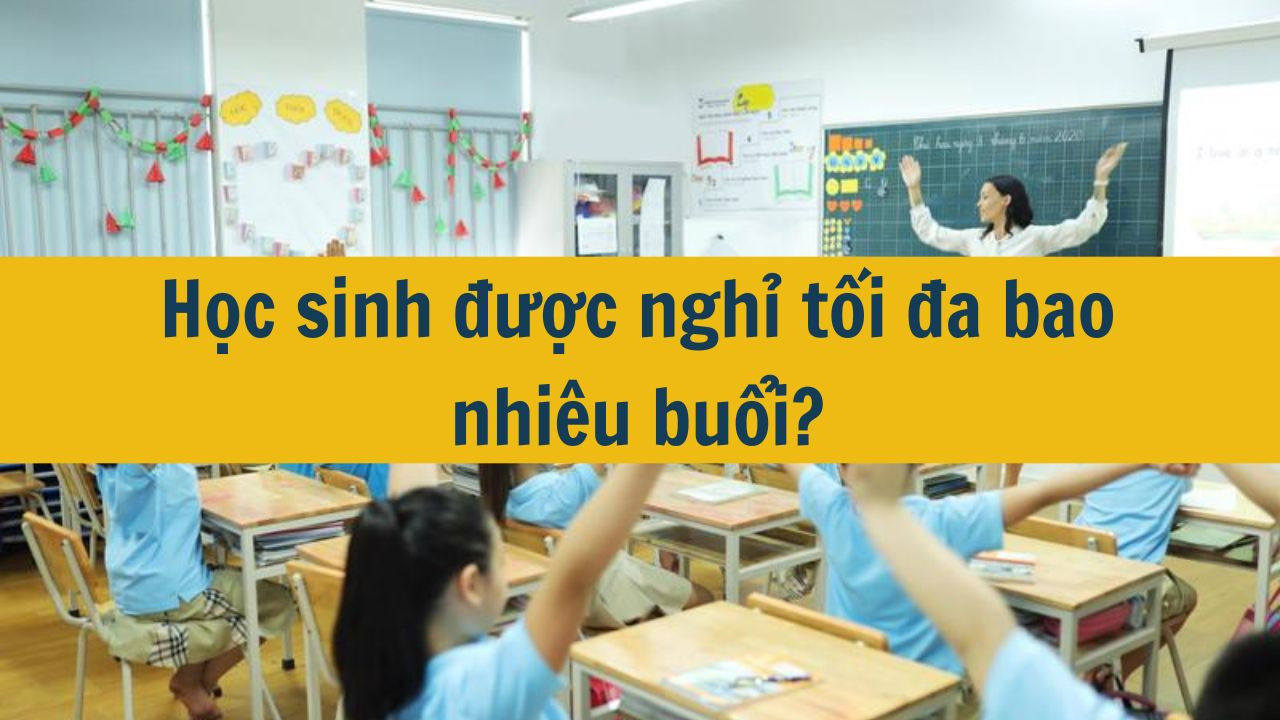
Học sinh được nghỉ tối đa bao nhiêu buổi?
Việc nghỉ học của học sinh luôn phải tuân thủ các quy định của nhà trường để đảm bảo không ảnh hưởng đến việc học tập và tiến độ chương trình. Tuy nhiên, nhiều phụ huynh và học sinh vẫn thắc mắc về số buổi nghỉ học tối đa mà học sinh có thể nghỉ trong một học kỳ hay năm học mà không bị ảnh hưởng đến kết quả học tập. Bài viết này sẽ giải đáp câu hỏi về số buổi nghỉ học tối đa của học sinh và các quy định liên quan. 10/02/2025Mẫu đơn xin nghỉ học dài ngày mới nhất 2025

Mẫu đơn xin nghỉ học dài ngày mới nhất 2025
Trong một số tình huống bất khả kháng, học sinh hoặc sinh viên có thể cần phải nghỉ học trong thời gian dài. Để đảm bảo việc nghỉ học diễn ra đúng quy định, việc viết đơn xin nghỉ học dài ngày là rất quan trọng. Mẫu đơn xin nghỉ học dài ngày mới nhất 2025 sẽ giúp bạn trình bày lý do nghỉ hợp lý và được sự chấp thuận từ nhà trường. Bài viết này sẽ cung cấp hướng dẫn chi tiết và mẫu đơn mới nhất để bạn có thể sử dụng khi cần. 10/02/202504 mẫu đơn xin nghỉ học bằng Tiếng Anh School Leave Letter mới nhất 2025

04 mẫu đơn xin nghỉ học bằng Tiếng Anh School Leave Letter mới nhất 2025
Việc xin nghỉ học là điều không thể tránh khỏi trong quá trình học tập, và viết một đơn xin nghỉ học hợp lý là cần thiết để tuân thủ quy định của trường. Mẫu đơn xin nghỉ học bằng Tiếng Anh (School Leave Letter) giúp học sinh trình bày lý do nghỉ một cách rõ ràng và trang trọng. Bài viết này sẽ cung cấp mẫu đơn xin nghỉ học bằng Tiếng Anh mới nhất 2025 để bạn có thể sử dụng khi cần thiết. 10/02/2025Đơn xin phép nghỉ học vì lý do sức khỏe mới nhất 2025
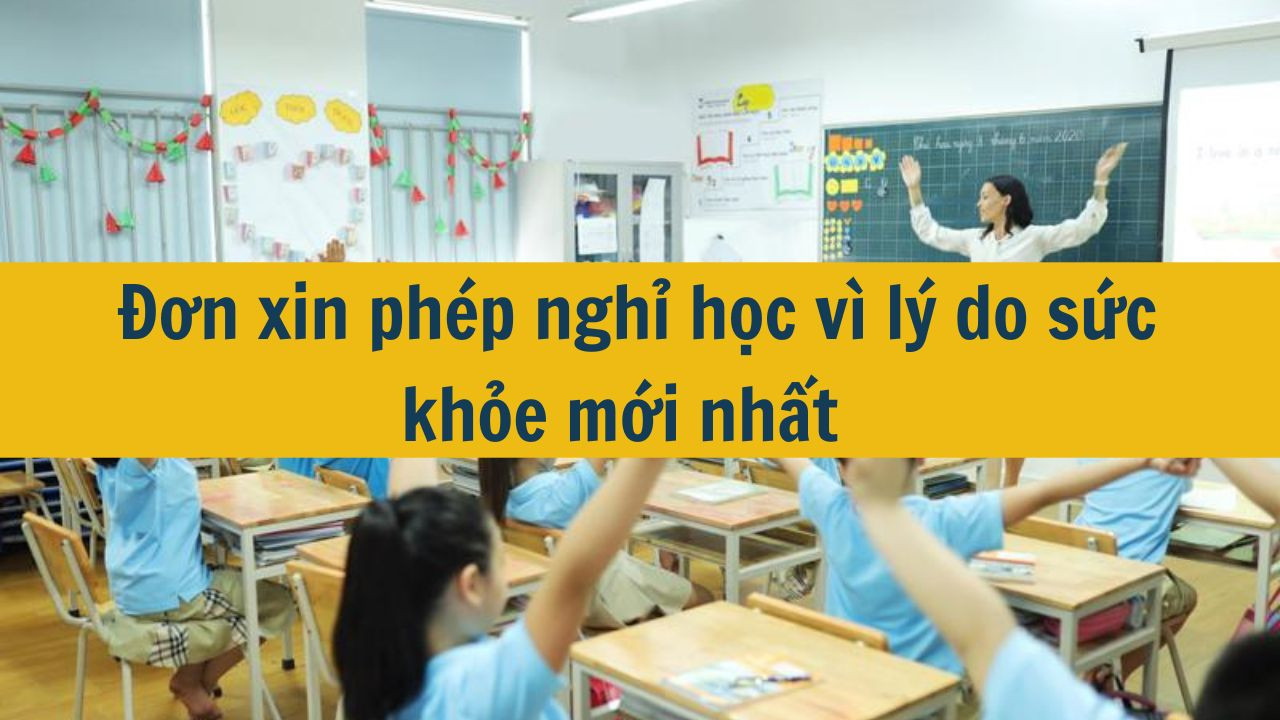
Đơn xin phép nghỉ học vì lý do sức khỏe mới nhất 2025
Trong môi trường học tập, sức khỏe luôn là yếu tố quan trọng giúp sinh viên duy trì hiệu quả học tập và sự tham gia vào các hoạt động của trường. Tuy nhiên, khi gặp phải tình trạng sức khỏe không tốt, việc nghỉ học là điều cần thiết để bảo vệ sức khỏe và tránh ảnh hưởng đến sự tập trung trong học tập. Để nghỉ học một cách hợp lý và đúng quy định, sinh viên cần phải viết đơn xin phép nghỉ học, trong đó nêu rõ lý do nghỉ và thời gian vắng mặt. Trong bài viết này, chúng tôi sẽ hướng dẫn bạn cách viết "Đơn xin phép nghỉ học vì lý do sức khỏe" mới nhất năm 2025, giúp bạn trình bày một cách rõ ràng, đúng yêu cầu của nhà trường. 10/02/2025Mẫu đơn xin nghỉ học đại học đầy đủ mới nhất 2025

Mẫu đơn xin nghỉ học đại học đầy đủ mới nhất 2025
Vì nhiều lý do khách quan mà trong một số trường hợp sinh viên phải nghỉ học. Vậy pháp luật hiện hành có quy định cụ thể về việc nghỉ học của sinh viên không? Để hiểu rõ hơn, chúng tôi sẽ giải đáp cho bạn đọc qua bài viết Mẫu đơn xin nghỉ học đại học đầy đủ mới nhất 2025. 10/02/2025Mẫu đơn xin nghỉ học cho học sinh trung học mới nhất 2025
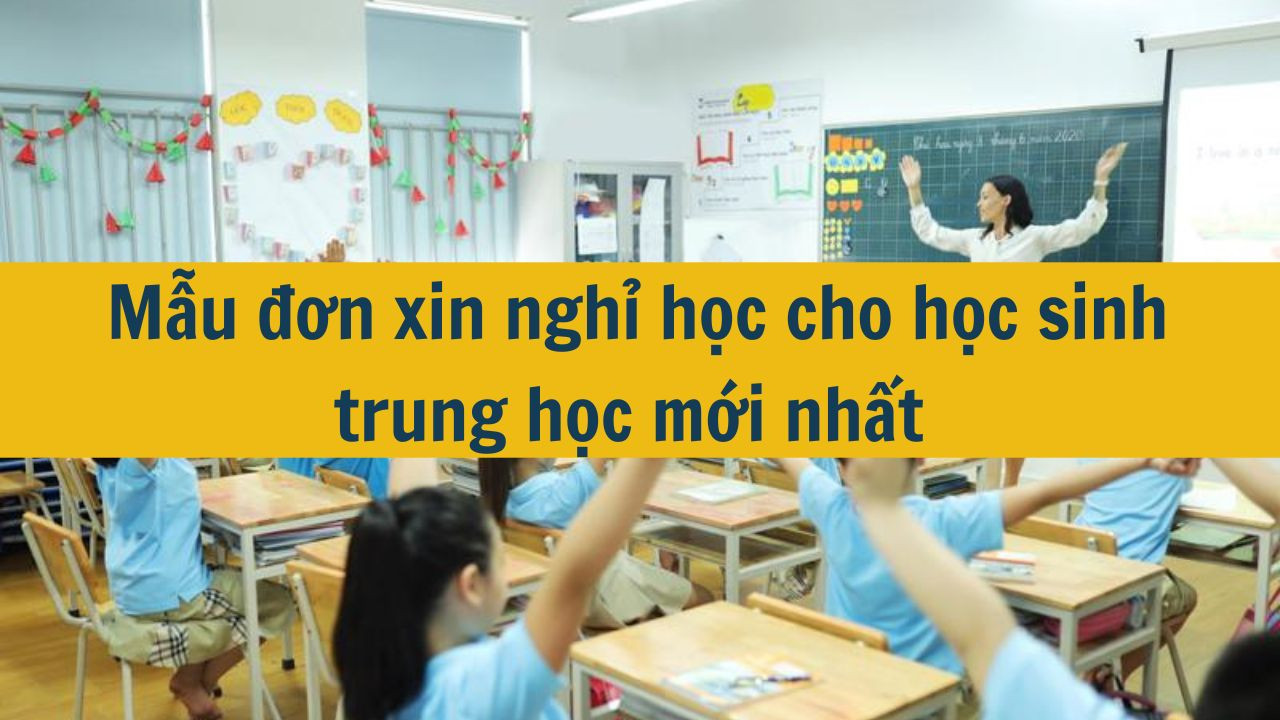
Mẫu đơn xin nghỉ học cho học sinh trung học mới nhất 2025
Vì nhiều lý do khách quan mà trong một số trường hợp học sinh phải nghỉ học. Vậy pháp luật hiện hành có quy định cụ thể về việc nghỉ học của học sinh không? Để hiểu rõ hơn, chúng tôi sẽ giải đáp cho bạn đọc qua bài viết Mẫu đơn xin nghỉ học cho học sinh trung học mới nhất 2025. 10/02/2025Mẫu đơn xin nghỉ học cho học sinh tiểu học mới nhất 2025
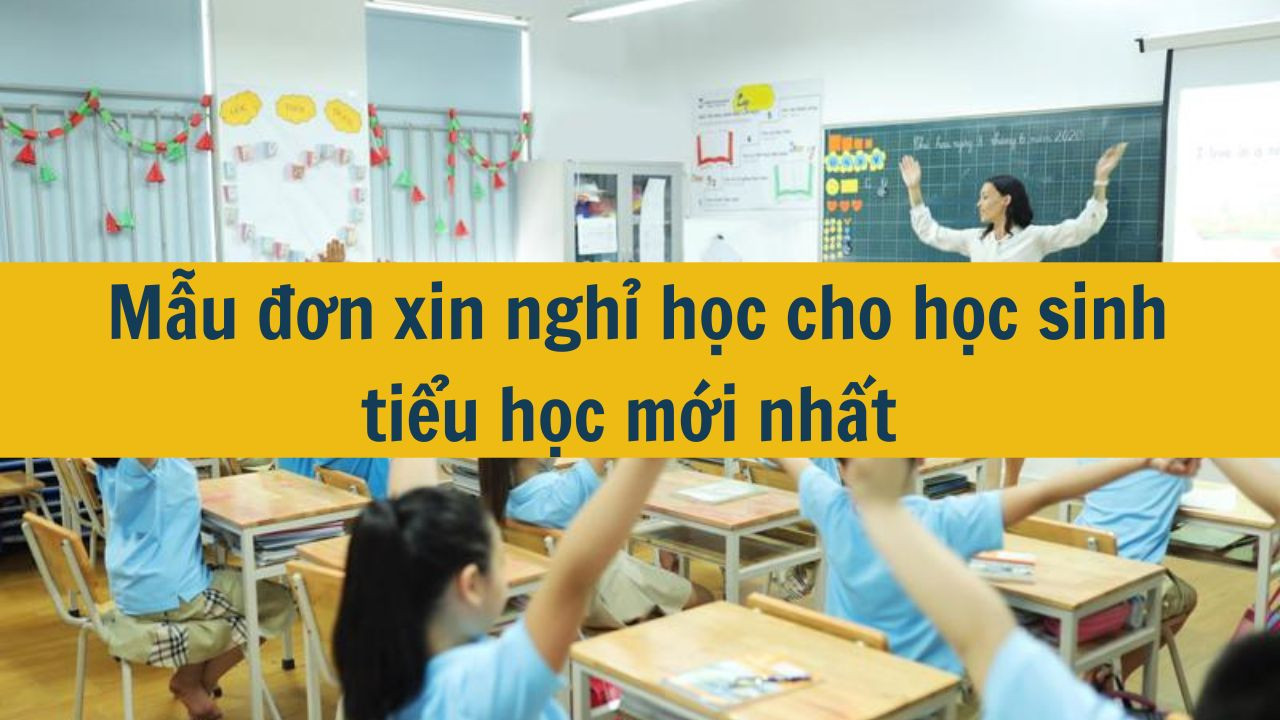
Mẫu đơn xin nghỉ học cho học sinh tiểu học mới nhất 2025
Vì nhiều lý do khách quan mà trong một số trường hợp học sinh phải nghỉ học. Vậy pháp luật hiện hành có quy định cụ thể về việc nghỉ học của học sinh không? Để hiểu rõ hơn, chúng tôi sẽ giải đáp cho bạn đọc qua bài viết Mẫu đơn xin nghỉ học cho học sinh tiểu học mới nhất 2025. 10/02/2025Cách viết đơn xin nghỉ học chuẩn mới nhất 2025
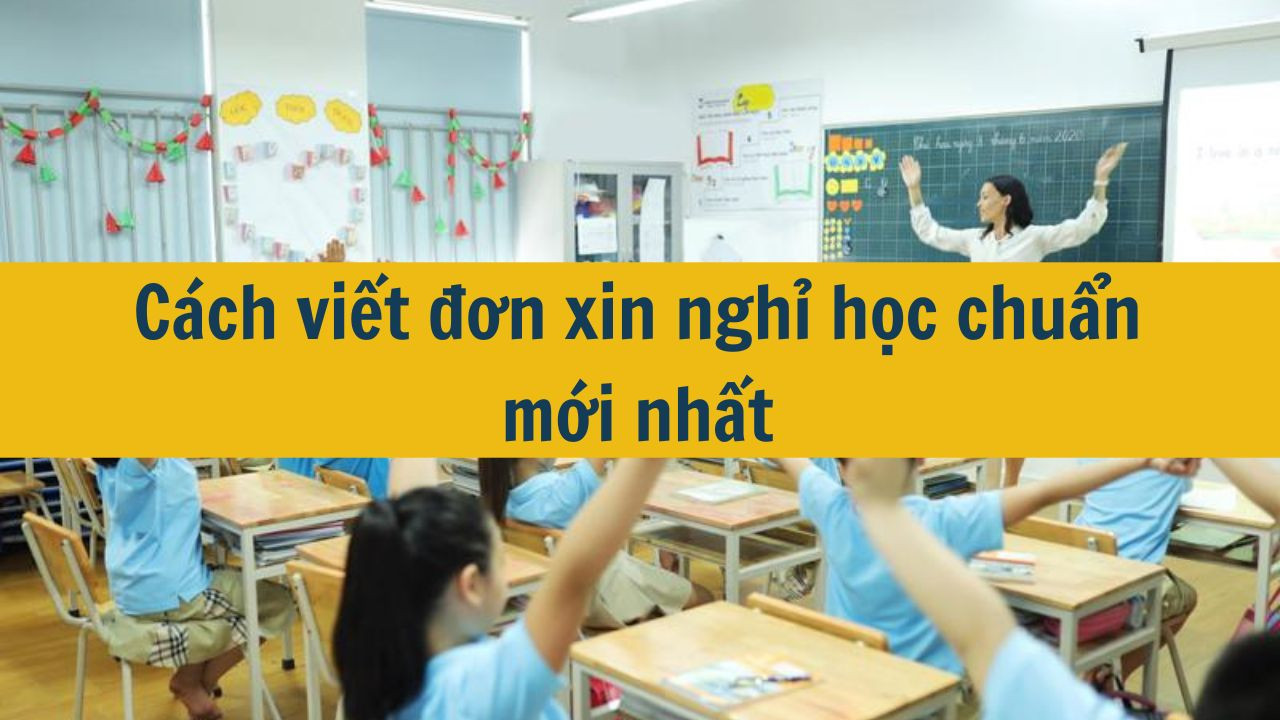
Cách viết đơn xin nghỉ học chuẩn mới nhất 2025
Vì nhiều lý do khách quan mà trong một số trường hợp học sinh phải nghỉ học. Vậy pháp luật hiện hành có quy định cụ thể về việc nghỉ học của học sinh không? Để hiểu rõ hơn, chúng tôi sẽ giải đáp cho bạn đọc qua bài viết. Cách viết đơn xin nghỉ học chuẩn mới nhất 2025. 10/02/202505 mẫu đơn xin nghỉ phép học sinh chi tiết thuyết phục mới nhất 2025
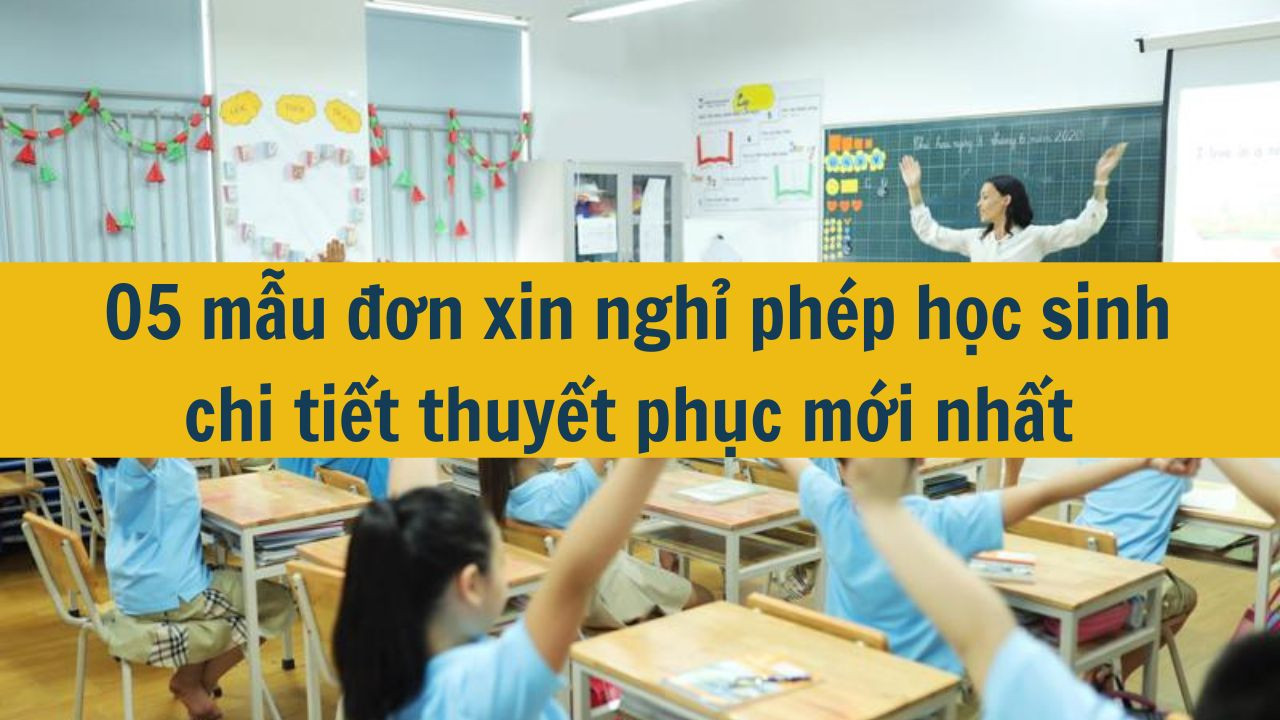

 Thông tư 22/2021/TT-BGDĐT đánh giá học sinh trung học cơ sở (Bản Pdf)
Thông tư 22/2021/TT-BGDĐT đánh giá học sinh trung học cơ sở (Bản Pdf)
 Thông tư 22/2021/TT-BGDĐT đánh giá học sinh trung học cơ sở (Bản Word)
Thông tư 22/2021/TT-BGDĐT đánh giá học sinh trung học cơ sở (Bản Word)